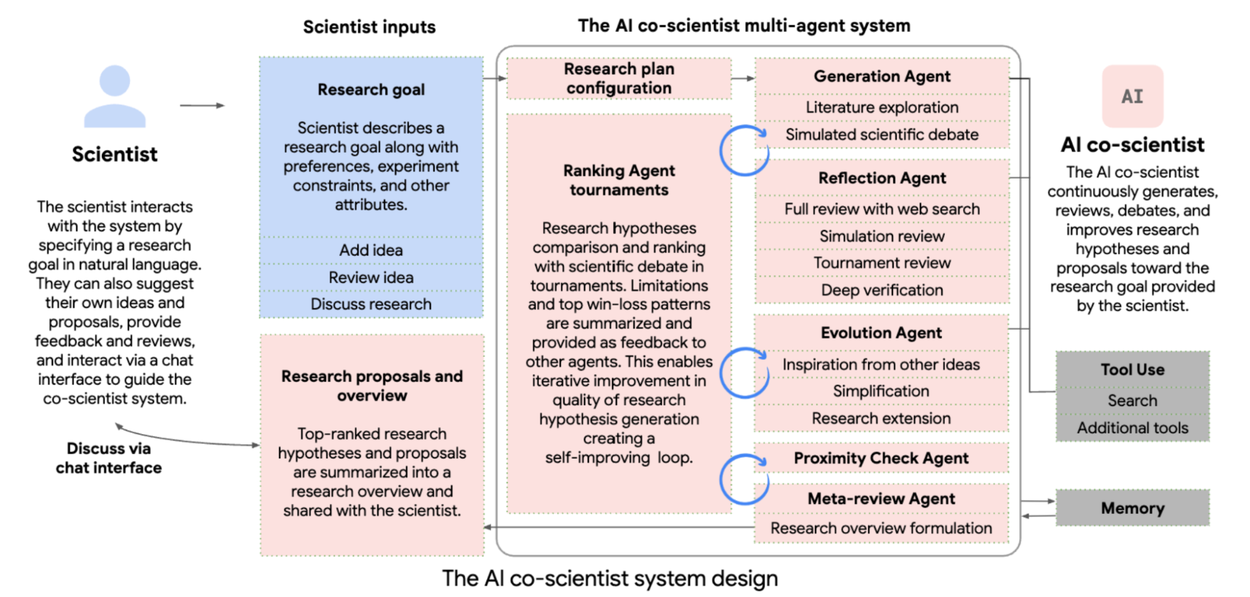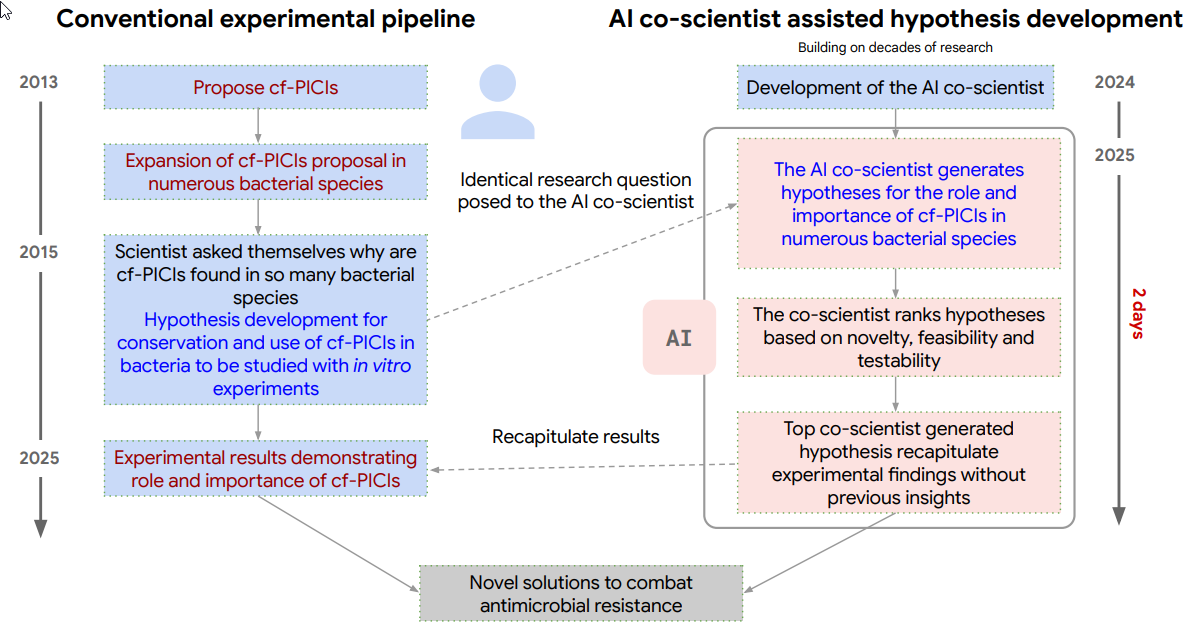Scientific research is propelled forward by creative thinking and scientific experience, well it used to be. Now as we move deeper into the age of AI it is becoming evident that we will see Ai transform how scientific research is carried out from conceptualization to mass production.
With the introduction of Ai Co-Scientist, Google is pushing the boundaries of novel research and development in the life sciences. They go as far as to show how the new AI agent proposed research and elucidated results in just 2 days that took ICL (Imperial College London) scientists nearly 12 years to work out.
"The system can search and reason over relevant literature to summarize and synthesize prior work and build on it to propose novel, original research hypotheses and experimental protocols for downstream validations" (paper)

Fig 1: The AI co-scientist system design and experimental validation summary. (a) Here, we illustrate the different components of the the AI co-scientist multi-agent system, and its interaction paradigm with scientists. Given a research goal in natural language, the co-scientist generates novel research hypotheses and proposals. The system employs specialized agents — Generation, Reflection, Ranking, Evolution, Proximity (which evaluates relatedness), Meta-review (which provides high level analysis) — to continuously generate, debate, and evolve research hypotheses within a tournament framework. Feedback from the tournament enables iterative improvement, creating a self-improving loop towards novel and high-quality outputs. The co-scientist leverages tools, including web search and specialized AI models to improve the grounding and quality of generated research hypotheses. Scientists can converse with the co-scientist in natural language to specify research goals, incorporate constraints, provide feedback and suggest new directions for explorations via the designated user interface. (b) We perform end-to-end validation of the co-scientist generated hypotheses in three important topics of biomedicine with varied complexity — suggesting novel drug repurposing candidates for acute myeloid leukemia (AML) (upper panel), discovering novel epigenetic targets for liver fibrosis treatment (middle panel), and recapitulating the discovery of novel mechanism of gene transfer evolution in bacteria key to anti-microbial resistance (lower panel). The co-scientist’s hypotheses for these three settings are externally, independently validated by in vitro laboratory experiments and detailed in separate preprints co-timed with this work. In the figure, blue denotes expert scientist inputs while red denotes the co-scientist agents or outputs.
The Overall Ai Co-Scientist Process
This work does not aim to completely automate the scientific process with AI. Instead, the co-scientist is purpose-built for a “scientist-in-the-loop” collaborative paradigm, to help domain experts augment their hypothesis generation process and guide the exploration that follows.
In this article we take a look at the recent publication by Google AI Research and how the potential for "in silica" (scientific discovery through computing) research and discovery will disrupt the scientific discovery process.
Introducing AI Co-Scientist
Google has recently published a paper introducing the AI Co-Scientist, a multi-agent system built on Gemini 2.0, that is designed to enhance scientific discovery by generating novel research hypotheses and proposals.
Utilizing a generate, debate, and evolve approach, the system leverages flexible compute scaling and a tournament evolution process to improve hypothesis quality along with a "scientist in the loop".
The co-scientist is designed to act as a helpful assistant and collaborator to scientists and to help accelerate the scientific discovery process. (paper)
Focused on three biomedical areas — drug repurposing, novel target discovery, and bacterial evolution mechanisms — the AI co-scientist has shown very promising results. It identified drug candidates for acute myeloid leukemia with in vitro tumor inhibition, proposed new epigenetic targets for liver fibrosis validated by anti-fibrotic activity, and discovered a novel gene transfer mechanism in bacterial evolution. These findings highlight the potential of AI to significantly advance biomedical research and scientific discovery.
The Co-Scientist Process
Here is a simplified outline of the steps the AI co-scientist takes to return a solution:
- Scientist Inputs: The scientist provides a research goal, preferences, and constraints in natural language.
- Multi Agent Review and Generation Cycles: The system explores relevant literature and generates initial research hypotheses. The generated hypotheses are reviewed for correctness, quality, and novelty. Hypotheses are compared and ranked through a tournament-based evaluation. Top-ranked hypotheses are refined and improved iteratively. Insights from reviews and rankings are synthesized to enhance future hypothesis generation.
- Agent Supervisor Response: The top-ranked hypotheses and proposals are summarized and shared with the scientist.
- Scientist Feedback: The scientist reviews the summary, provides feedback, and may suggest new directions.
- Iterative Improvement: The system continuously improves hypotheses based on feedback and additional computation.
This streamlined process ensures that the AI co-scientist generates high-quality, novel, and testable research hypotheses aligned with the scientist's goals.
Given a research goal specified in natural language, the system can search and reason over relevant literature to summarize and synthesize prior work and build on it to propose novel, original research hypotheses and experimental protocols for downstream validations (Figure 1).
The Components of Ai Co-Scientist
To build Co-Scientist Google researchers determined a workflow analogous to human scientific discovery. This allows the problem to be defined in natural language then handed off to a series of "specialists" to work the problem, and a supervisor to manage the specialists and combine their work into a plausible scientific discovery which is then proposed to the human scientist.
This appears to have a Chain Of Agents (recently proposed by Google Ai Research) style paradigm with the agents further classified into specialists. This process is reported to elucidate novel discoveries in biochemical research with Ai Co-Scientist.
The Co-Scientist agent can be broken down into 4 main components.
- Natural language interface: Allows scientists to interact with and supervise the system using natural language, enabling them to define and refine research goals, provide feedback, and guide the system's progress.
- Asynchronous task framework: Utilizes a multi-agent system where specialized agents operate as worker processes within a continuous and configurable task execution framework, managed by a Supervisor agent. This design allows for flexible and effective use of computational resources and iterative improvement of scientific reasoning capabilities.
- Specialized agents: Breaks down the process of scientific reasoning and hypothesis generation into sub-tasks, each executed by individual specialized agents equipped with customized instruction prompts. These agents are coordinated by the Supervisor agent.
- Context memory: Uses a persistent context memory to store and retrieve the states of the agents and the system, enabling iterative computation and scientific reasoning over long time horizons.
The system is built on the Gemini 2.0 model, which serves as the foundational large language model (LLM) for all agents. The design reflects iterative developments based on the current capabilities of the underlying LLMs. The authors did not explore the application of other LLMs or specialty models leading to opportunities to study how model variance will effect response (discoveries).
The Results from Biomedicine Application
The AI co-scientist, has demonstrated significant potential in advancing biomedical research through its innovative approach to hypothesis generation and validation. The authors collaborated with Stanford University and Imperial College London to validate Co-Scientist results during their evaluation on the results below.
- Drug Repurposing for Acute Myeloid Leukemia (AML): The AI co-scientist identified several drug candidates, including Binimetinib and Pacritinib, which showed promising tumor inhibition in vitro at clinically relevant concentrations.
- Novel Target Discovery for Liver Fibrosis: The system proposed new epigenetic targets for liver fibrosis. These targets were validated by demonstrating significant anti-fibrotic activity and liver cell regeneration in human hepatic organoids.
- Mechanisms of Bacterial Evolution and Antimicrobial Resistance: The AI co-scientist independently recapitulated unpublished experimental results by discovering a novel gene transfer mechanism in bacterial evolution, highlighting its ability to mirror and accelerate scientific discovery. This process took the ICP team nearly 12 years to research while the Co-Scientist took about 2 days, highlighting the potential for rapid advancement of the scientific process.

Figure 13 | Timeline of the conventional experimental validation and the AI co-scientist-assisted hypothesis development for capsid-forming phage-inducible chromosomal islands (cf-PICIs), key to antibiotic resistance (AMR). Blue box: Scientist inputs. Red box: The AI co-scientist system. Red text: wet lab experimental setting. Blue text: research hypothesis generation. (paper)
"Its worth noting that while the co-scientist generated this hypothesis in just two days, it was building on decades of research and had access to all prior open access literature on this topic." (paper)
These findings underscore the AI co-scientist's capability to generate high-quality, novel hypotheses and its potential to significantly augment scientific research and discovery processes.
The Limitations of Co-Scientist
While the agent shows remarkable potential to disrupt drug discovery and biomedicine, it is not without its limitations. The authors acknowledge its limitations in several areas:
- Literature Search and Reasoning: The AI co-scientist may miss critical prior works due to reliance on open-access literature and may omit relevant studies if incorrectly deemed irrelevant.
- Lack of Access to Negative Results: The system likely has limited access to unpublished negative experimental results, which experienced scientists often use to prioritize research.
- Multimodal Reasoning and Tool-Use: The AI co-scientist may not fully utilize data encoded in figures and charts, and its ability to integrate information from domain-specific datasets and knowledge graphs needs improvement.
- Evaluation Metrics and Broader Assessments: Current evaluations are preliminary, and a comprehensive, systematic evaluation across diverse scientific disciplines is necessary to determine generalizability.
- Inherited Limitations of Frontier LLMs: The system may propagate factual inaccuracies and hallucinations present in the underlying large language models (LLMs).
These limitations highlight areas for further development and the need for continued improvement to enhance the AI co-scientist's effectiveness and reliability in scientific research. The future availability of super performance computing will also likely play a role in the effectiveness of the Co-Scientist for novel research elucidation as the process is compute and time intensive currently.
Trusted Tester Beta Access
Access to the system for research organizations is now available through the Google Trusted Tester Program. Interested research organizations around the world to consider joining this program here.
Summary
The AI co-scientist represents a significant advancement in AI-assisted augmentation of scientific research and the acceleration of scientific discovery. Its capability to generate novel, testable hypotheses across a wide range of scientific and biomedical fields, some of which are supported by experimental findings, coupled with its ability for recursive self-improvement with increased computational resources, highlights its potential to substantially accelerate scientists' efforts to tackle major challenges in human health, medicine, and science.
This innovation opens up numerous questions and opportunities. By applying an empirical and responsible scientific approach to the AI co-scientist system itself, we can safely explore its vast potential, demonstrating how collaborative and human-centered AI systems can enhance human ingenuity and expedite scientific discovery.

Powering Scientific Discovery with Ai : Google A.I. Co-Scientist released to Trusted Tester Access
Towards an AI co-scientist